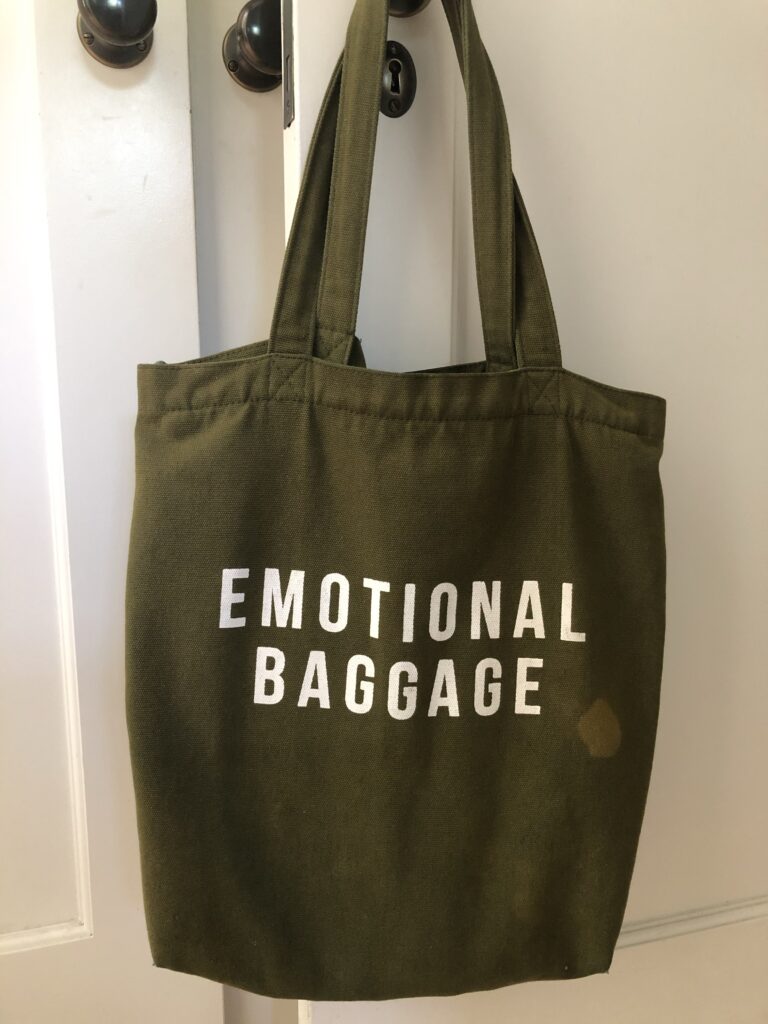What’s in Your Pandemic Emotional Baggage?
Usually about this time of the year I’m packing or unpacking. Packing to leave for vacation or unpacking once I arrive somewhere.
Right now, I’m doing neither. I’m still dealing with baggage, though. My emotional baggage.
Several years ago, I bought this purse at the Rijksmuseum in Amsterdam.

For those of you who don’t know me personally, yes, I did go through the museum before hitting the gift shop. The list of must-see art there is intimidating to get through. My favorites include Still Life with Asparagus (White asparagus! Very exotic.) and this Rembrandt self-portrait, titled, of course, Self-portrait. He is rocking a pandemic hairstyle.
Anyway, what a cool bag. An actual emotional baggage purse.
I was in Amsterdam to facilitate EQ (Emotional Intelligence) workshops for a client, so I discovered a great prop that wouldn’t take up space in my luggage (get it?!) and actually could be used to bring more stuff home.
At the time, I didn’t realize how much attention the purse would attract. I’ve been in subway cars, airports, airplanes, offices, and cafes, and a lot of people comment on it. They chuckle and say something like, “I love your bag” or “Oh, how funny, I have tons of that baggage, too.”
My goal was never to draw people to me or comment on the bag. I’m not looking to start conversations with strangers, especially on an airplane or in a crowded train car. It’s a funny bag, and again, a great prop.
I use the concept of emotional baggage often with clients: identifying what’s in their baggage. Identifying the rocks they are dragging around with them. The beliefs—many false—that they allow to take up space in their luggage.
Here are three of the coaching questions I use with clients as we begin to identify emotional baggage that prevents them from being an awesome leader:
- What are you worried about?
- What’s making you feel hesitant?
- Which thoughts are preventing you from doing great work?
The answers to these questions help us identify what’s in their work emotional baggage. We have to name the rocks, identify when they are coming up and why, where they come from, and what to do to break them down.
If you’re familiar with your emotional baggage, you know the bag isn’t just a symbol. You know that those rocks feel real. They feel like big red bricks, as you drag them around with you, from meeting to meeting, email to email, conversation to conversation.
For me, I realize the pandemic makes the need for my emotional baggage to be larger. There are more concerns and worries rumbling around, trying to get into that bag. No more carry-on size emotional baggage.
Those worries seem more like threats now. As a client said to me last week, “It used to be that my baggage held me back. Now, my worries are about things that could actually kill me.”
[Sigh. Deep breath.]
Yes.
What’s around us is an existential threat. I thought for a while about using that word. It’s big and theoretical, and it fits. Our lives are changing. Our values are shifting. We’re trying to keep relationships going and build new ones with people we’ve never met before. We’re moving in different directions. Some of us are making big physical moves, and some of us sitting in the same spot.
Here are a few of the rocks I’m working through: Do I hug my parents? Do I go to the dentist? Do I stay in a hotel?
These weren’t rocks in my baggage pre-March 2020. But they’re in the purse now, and they are heavy.
I can quickly get caught up in the weight of this baggage and turn these worries into possible extremes. I catastrophize. Like this: Will I ever go on vacation again? (Yep, back to that “real” suitcase.)
With more to worry about, I realize I need more time to process these rocks. To unpack my baggage. And so do many other people.
Recognize you need more time to work through these things. Acknowledge you need more time to get through pandemic emotional baggage.
With my coaching clients, I use this list to unpack and organize baggage:
- List the rocks.
- Which ones can you control? Which ones can’t you? Get the latter list out of the baggage now.
- Organize what remains into the work baggage and the personal baggage. (WFH has led to close to zero separation between work and home. Separate now, as much as you can.)
- Identify the top 3 in the work list. (With my clients, I start with the work list and depending on the person, sometimes we tackle the personal ones, too).
- Rock by rock, why do you feel that way? What’s the history?
- List one action item for today for each rock. Just one.
- How do you want to be recognized for the work you do with your rocks?
So, what’s in your pandemic emotional baggage? Reply and share, and also walk yourself through these steps.
No pet rocks are allowed. You can’t hold on to them. No pet rocks. 😉
Resources You Need Now: Two Must-Watch Webinars
Here are two webinars I think you must watch. I know “must watch” is an overused term. I agree, but I’m not exaggerating by using it here. Both webinars are free and available to watch post their live event dates.
The first one is Leadership in Turbulent Times. Yes, the title feels trite, but don’t let that stop you: this was full of practical, thoughtful insight. It was hosted by the Stanford Innovation and Entrepreneurship Program and facilitated by Bob Sutton, organizational psychologist and Stanford professor and author of many books, including Good Boss, Bad Boss, The Asshole Survival Guide, The No Asshole Rule, and others. (If you’re an L&D leader, The Knowing-Doing Gap, co-authored with Jeffrey Pfeffer, should already be on your desk). Kaye Foster was the speaker. She’s an advisor with Boston Consulting Group, a former HR VP, and a Trustee of Spelman College.
Bob Sutton is a super entertaining speaker, and he’s an accessible thinker: he actively participates in discussions on LinkedIn. I listened to an IDEO podcast with him earlier in the pandemic Spring: it was about leaders setting the tempo for change. I loved the ideas he shared, and then I thought, I MUST go back to school and get an MBA! Impractical idea x10. Stanford’s MBA is very expensive, not sure I’d get in (ouch—the truth hurts even when you type it), and the “big” reason is that there is no way I could make that work with all the other work I’m doing.
In reality, I just want to be able to read books, meet professors, see behind the professor-wizard curtain of their research, and learn. One day, maybe. Anyway, check out the webinar.
The second webinar is next week, and it’s from Gallup: Rating World Leaders in the Age of a Global Crisis. Sooo, did that title get your attention?
I can’t wait to hear Gallup’s experts talk about and compare pandemic-era leadership in the US, Russia, Germany, and China. I think this webinar should be required watching for all leaders.
Anything Else? Yes, More Content Coming.
Awesome Manager Previews available in August
In late August, I’ll be ready to share preview modules for Awesome Manager. HR leaders, L&D leaders, functional heads, and heck, leaders of any type—reach out to me and learn more, so you’re first on the list to preview modules. You can then have all your leaders join the program.
I’ve taken all the tips and tricks I’ve shared with leaders and teams over the last 20+ years and created an online, at-your-own-pace, when you want it, 15-minutes-at-a-time training program: Awesome Manager. Learn how to set goals, delegate, give feedback, tackle performance challenges, and more. Weekly group coaching calls, a private online forum for each company/cohort where a coach (me) shares thoughts and answers.
Executive Presence, Building and Maintaining Relationships, and Great Behavioral Interviewing Questions: Yes, Still Coming
All this content coming soon—in webinar format.
I will also be hosting a SHRM.org webinar in mid to late August on relationships and EQ. Date TBD.
Finally, An Inappropriate Movie Theme as My Phone Ringer: Remember Rudy the Rabbit?
Each summer I use one of the theme songs from the movie “Meatballs” as my phone’s ringer: “Are you ready for the summer?” YES.
So many things about the movie and its poster are inappropriate, sexist, chauvinist, yikes, you name it.
Yet, it is still a story about a kid who is sent to summer camp, and he is lonely and hurting. And someone notices him, speaks to him, and takes care of him. Yes, that person is Bill Murray. He’s zany, he’s mentally unbalanced, and he cares.
There is probably someone around you who needs you to say hi and notice them. Theme song optional.
Take care of your teams, leaders. I still haven’t met a leader who over communicates. Make it your goal to prove me wrong, and say, “It’s me, Leila. I’m the one communicating too much.” 🙂
Please share your thoughts and talk to you in two weeks,
Leila






